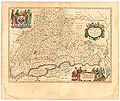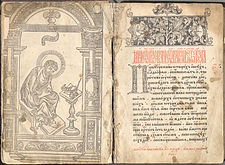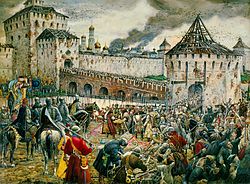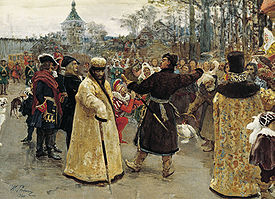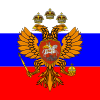- Tsardom of Russia
-
The subject of this article was previously also known as Russia. For other uses, see Russia (disambiguation).For Kingdom of Rus', see Kingdom of Galicia–Volhynia
Tsardom of Russia
Царство Русcкое
Tsarstvo Russkoye← 
1547–1721  →
→

Civil Ensign Coat of arms Territory of Muscovy / Russia in 1500, 1600 and 1700. Capital Moscow
(1547–1712)
Alexandrov Kremlin
(1564–1581)
Saint Petersburg
(1712–1721)Language(s) Russian Religion Russian Orthodoxy Government Absolute monarchy &
Tsarist autocracyTsar (Emperor) - 1547–1584 Ivan IV (first) - 1682–1721 Peter I (last) Legislature Zemsky Sobor History - Coronation of Ivan IV 16 January 1547 - Time of Troubles 1598–1613 - Russo-Polish War 1654–1667 - Great Northern War 1700–1721 - Treaty of Nystad 10 September 1721 - Proclamation of the Russian Empire 22 October 1721 Currency Ruble The Tsardom of Russia (also known as Tsardom of Muscovy; officially Русское царство[1][2] (Tsardom of Rus') or, in hellenized form, Российское царство[3][4]) was the name of the centralized Russian state from Ivan IV's assumption of the title of Tsar in 1547 till Peter the Great's foundation of the Russian Empire in 1721.
From 1550 to 1700, Russia grew 35,000 km2 (Holland's size) a year. [5] The period includes the upheavals of the transition from the Rurik to the Romanov Dynasty, drawn-out military conflict with the Polish-Lithuanian Commonwealth as well as the Russian conquest of Siberia, leading up to the 42-year reign of Peter the Great, who ascended in 1682 and transformed the Tsardom into a major European power, after a military victory over Sweden and Poland implemented substantial reforms and proclaimed the Russian Empire (Российская Империя) in 1721 making it a recognized European power.
Contents
Name
Further information: Rus (name) and Muscovy (disambiguation)While Ivan assumed the title of "Tsar and Grand Duke of the entire Rus'" (Царь и Великий князь всея Руси), officially renaming the Grand Duchy of Moscow to Tsardom of Russia, the state remained partly referred to as Muscovy (Moscovia) throughout Europe, predominantly in its Catholic part. The two names "Russia" and "Muscovy" appear to have co-existed as interchangeable during the later 16th and throughout the 17th century with different maps and sources using different names.
-
Russia, Mercator, 1595
-
Combined usage: Russia vulgo Moscovia, Atlas Maior, 1645
According to prominent historians like Alexander Zimin or Anna Khoroshkevich, the continuous using of the term Muscovy was a result of the traditional habit and the need to distinguish between the Muscovite and the Lithuanian part of the Rus, as well as of the political interests of the Polish-Lithuanian Commonwealth which competed with Moscow for the western parts of the Rus. Due to the propaganda of the Commonwealth[6][7] as well as of the Jesuits the term Muscovy was used instead of Russia in many parts of Europe where prior to the reign of Peter the Great there was a lack of direct knowledge of the country.
Other influential historians like Sigurd Shmidt, however, consider the name "Tsardom of Muscovy", or "Muscovite Tsardom" (Московское царство).[8][9] to correspond to the Russian historical usage, too.
Byzantine heritage
Main articles: Tsar and Third Rome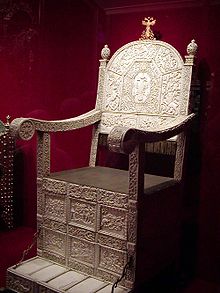 Ivory throne of Ivan the Terrible.
Ivory throne of Ivan the Terrible.
History of Russia 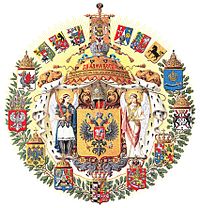
This article is part of a seriesVolga Bulgaria (7th–13th) Khazar Khaganate (7th–10th) Rus' Khaganate (8th–9th) Kievan Rus' (9th–12th) Vladimir-Suzdal (12th–14th) Novgorod Republic (12th–15th) Mongol invasion (1220s–1240s) Tatar Yoke (13th–15th) Grand Duchy of Moscow (1340–1547) Tsardom of Russia (1547–1721) Russian Empire (1721–1917) Russian Provisional Government / Russian Republic (1917) Russian SFSR / Soviet Union (1917–1991) Russian Federation (1992–present)
Russia Portal
By the 16th century, the Russian ruler had emerged as a powerful, autocratic figure, a Tsar. By assuming that title, the sovereign of Moscow tried to emphasize that he was a major ruler or emperor on a par with the Byzantine emperor or the Mongol khan. Indeed, after Ivan III's marriage to Sophia Palaiologina, the niece of the last Byzantine emperor, the Moscow court adopted Byzantine terms, rituals, titles, and emblems such as the double-headed eagle, which survives as the coat of arms of Russia.
At first, the Byzantine term autokrator expressed only the literal meaning of an independent ruler, but in the reign of Ivan IV (r. 1533-1584) it came to mean unlimited rule. Ivan IV was crowned Tsar and thus was recognized, at least by the Russian Orthodox Church, as Emperor. Philotheus of Pskov had claimed that, once Constantinople had fallen to the Ottoman Empire in 1453, the Russian Tsar was the only legitimate Orthodox ruler and that Moscow was the Third Rome because it was the final successor to Rome and Constantinople, the centers of Christianity in earlier periods. That concept was to resonate in the self-image of Russians in future centuries.
Early reign of Ivan IV
The development of the Tsar's autocratic powers reached a peak during the reign of Ivan IV, and he became known as the Terrible (his Russian epithet, groznyi, means "foreboding"). Ivan strengthened the position of the Tsar to an exceptional degree, demonstrating the risks of unrestrained power in the hands of a mentally unstable individual. Although apparently intelligent and energetic, Ivan suffered from breakdowns of paranoia and depression, and his rule was disrupted by acts of intense violence.
Ivan IV became Grand Prince of Moscow in 1533 at the age of three. The Shuysky and Belsky factions of the boyars competed for control of the regency until Ivan assumed the throne in 1547. Reflecting Moscow's new imperial claims, Ivan's coronation as Tsar was a ritual modeled after those of the Byzantine emperors. With the continuing assistance of a group of boyars, Ivan began his reign with a series of useful reforms. In the 1550s, he declared a new law code, revamped the military, and reorganized local government. These reforms undoubtedly were intended to strengthen the state in the face of continuous warfare.
Foreign policies of Ivan IV
Main articles: Muscovite–Lithuanian Wars and Livonian WarRussia remained a fairly unknown society in western Europe until Baron Sigismund von Herberstein published his Rerum Moscoviticarum Commentarii (literally Notes on Muscovite Affairs) in 1549. This provided a broad view of what had been a rarely visited and poorly reported state. In the 1630s, the Russian Tsardom was visited by Adam Olearius, whose lively and well-informed writings were soon translated into all the major languages of Europe.
 Apollinary Vasnetsov. Arrival of heralds to the Kremlin. 20th century depiction.
Apollinary Vasnetsov. Arrival of heralds to the Kremlin. 20th century depiction.
Further information about Russia was circulated by English and Dutch merchants. One of them, Richard Chancellor, sailed to the White Sea in 1553 and continued overland to Moscow. Upon his return to England, the Muscovy Company was formed by himself, Sebastian Cabot, Sir Hugh Willoughby, and several London merchants. Ivan the Terrible used these merchants to exchange letters with Elizabeth I.
Despite the domestic turmoil of 1530s and 1540s, Russia continued to wage wars and to expand. It grew from 2.8 to 5.4 million km2 1533-84.[10] Ivan defeated and annexed the Khanate of Kazan on the middle Volga in 1552 and later the Astrakhan Khanate, where the Volga meets the Caspian Sea. These victories transformed Russia into a multiethnic and multiconfessional state which it continues to be today. The tsar now controlled the entire Volga River and gained access to Central Asia.
Expanding to the northwest toward the Baltic Sea proved to be much more difficult. In 1558 Ivan invaded Livonia, eventually involving himself in a twenty-five-year war against the Polish–Lithuanian Commonwealth, Sweden, and Denmark. Despite occasional successes, Ivan's army was pushed back, and the nation failed to secure a coveted position on the Baltic Sea.
Hoping to make profit from Russia's concentration on Livonian affairs, Devlet I Giray of Crimea, accompanied by as many as 120,000 horsemen, repeatedly devastated the Moscow region, until the Battle of Molodi put a stop to such northward incursions. But for decades to come, the southern borderland was annually pillaged by the Nogai Horde and the Crimean Khanate, who took local inhabitants with them as slaves. Tens of thousands of soldiers protected the Great Abatis Belt — a burden for a state whose social and economic development was stagnating. These wars drained Russia.
Oprichnina
Main article: OprichninaDuring the late 1550s, Ivan developed a hostility toward his advisers, the government, and the boyars. Historians have not determined whether policy differences, personal animosities, or mental imbalance caused his wrath. In 1565 he divided Russia into two parts: his private domain (or oprichnina) and the public realm (or zemshchina). For his private domain, Ivan chose some of the most prosperous and important districts of Russia. In these areas, Ivan's agents attacked boyars, merchants, and even common people, summarily executing some and confiscating land and possessions. Thus began a decade of terror in Russia which culminated in the Massacre of Novgorod (1570).
As a result of the policies of the oprichnina, Ivan broke the economic and political power of the leading boyar families, thereby destroying precisely those persons who had built up Russia and were the most capable of administering it. Trade diminished, and peasants, faced with mounting taxes and threats of violence, began to leave Russia. Efforts to curtail the mobility of the peasants by tying them to their land brought Russia closer to legal serfdom. In 1572 Ivan finally abandoned the practices of the oprichnina.
According to a popular theory, the oprichnina was started by Ivan in order to mobilize resources for the wars and to quell opposition to it. Regardless of the reason, Ivan's domestic and foreign policies had a devastating effect on Russia, and they led to a period of social struggle and civil war, the so-called Time of Troubles (Smutnoye vremya, 1598-1613).
Time of Troubles
Main article: Time of TroublesIvan IV was succeeded by his son Fedor, who was mentally deficient. Actual power went to Fedor's brother-in-law, the boyar Boris Godunov (who is credited with abolishing Yuri's Day, the only time of the year when serfs were free to move from one landowner to another). Perhaps the most important event of Fedor's reign was the proclamation of the Patriarchate of Moscow in 1589. The creation of the patriarchate climaxed the evolution of a separate and totally independent Russian Orthodox Church.
In 1598 Fedor died without an heir, ending the Rurik Dynasty. Boris Godunov then convened a Zemsky Sobor, a national assembly of boyars, church officials, and commoners, which proclaimed him tsar, although various boyar factions refused to recognize the decision. Widespread crop failures caused the Russian famine of 1601–1603, and during the ensuing discontent, a man emerged who claimed to be Tsarevich Demetrius, Ivan IV's son who had died in 1591. This pretender to the throne, who came to be known as False Dmitriy I, gained support in Poland and marched to Moscow, gathering followers among the boyars and other elements as he went. Historians speculate[11] that Godunov would have weathered this crisis had he not died in 1605. As a result, False Dmitriy I entered Moscow and was crowned tsar that year, following the murder of Tsar Fedor II, Godunov's son.
Subsequently, Russia entered a period of continuous chaos, known as The Time of Troubles (Смутное Время). Despite the Tsar's persecution of the boyars, the townspeople's dissatisfaction, and the gradual enserfment of the peasantry, efforts at restricting the power of the Tsar were only halfhearted. Finding no institutional alternative to the autocracy, discontented Russians rallied behind various pretenders to the throne. During that period, the goal of political activity was to gain influence over the sitting autocrat or to place one's own candidate on the throne. The boyars fought among themselves, the lower classes revolted blindly, and foreign armies occupied the Kremlin in Moscow, prompting many to accept Tsarist autocracy as a necessary means to restoring order and unity in Russia.
The Time of Troubles included a civil war in which a struggle over the throne was complicated by the machinations of rival boyar factions, the intervention of regional powers Poland and Sweden, and intense popular discontent, led by Ivan Bolotnikov. False Dmitriy I and his Polish garrison were overthrown, and a boyar, Vasily Shuysky, was proclaimed tsar in 1606. In his attempt to retain the throne, Shuysky allied himself with the Swedes, unleashing the Ingrian War with Sweden. False Dmitry II, allied with the Poles, appeared under the walls of Moscow and set up a mock court in the village of Tushino.
In 1609 Poland intervened into Russian affairs officially, captured Shuisky, and occupied the Kremlin. A group of Russian boyars signed in 1610 a treaty of peace, recognising Ladislaus IV of Poland, son of Polish king Sigismund III Vasa, as tsar. In 1611, False Dmitry III appeared in the Swedish-occupied territories, but was soon apprehended and executed. The Polish presence led to a patriotic revival among the Russians, and a volunteer army, financed by the Stroganov merchants and blessed by the Orthodox Church, was formed in Nizhny Novgorod and, led by Prince Dmitry Pozharsky and Kuzma Minin, drove the Poles out of the Kremlin. In 1613 a zemsky Sobor proclaimed the boyar Mikhail Romanov as tsar, beginning the 300-year reign of the Romanov family.
Romanovs
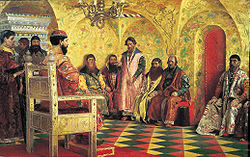 Andrei Ryabushkin. Tsar Michael at the Session of the Boyar Duma.
Andrei Ryabushkin. Tsar Michael at the Session of the Boyar Duma.
The immediate task of the new dynasty was to restore order. Fortunately for Russia, its major enemies, Poland and Sweden, were engaged in a conflict with each other, which provided Russia the opportunity to make peace with Sweden in 1617. The Polish–Muscovite War (1605–1618) was ended with the Truce of Deulino in 1618, restoring temporarily Polish and Lithuanian rule over some territories, including Smolensk, lost by the Grand Duchy of Lithuania in 1509.
The early Romanovs were weak rulers. Under Mikhail, state affairs were in the hands of the tsar's father, Filaret, who in 1619 became Patriarch of Moscow. Later, Mikhail's son Aleksey (r. 1645-1676) relied on a boyar, Boris Morozov, to run his government. Morozov abused his position by exploiting the populace, and in 1648 Aleksey dismissed him in the wake of the Salt Riot in Moscow.
After an unsuccessful attempt to regain Smolensk from Poland in 1632, Russia made peace with Poland in 1634. Polish king Władysław IV Vasa, whose father and predecessor was Sigismund III Vasa, had been elected by Russian boyars as tsar of Russia during the Time of Troubles, renounced all claims to the title as a condition of the peace treaty.
Legal code of 1649
The autocracy survived the Time of Troubles and the rule of weak or corrupt tsars because of the strength of the government's central bureaucracy. Government functionaries continued to serve, regardless of the ruler's legitimacy or the boyar faction controlling the throne. In the 17th century, the bureaucracy expanded dramatically. The number of government departments (prikazy ; sing., prikaz ) increased from twenty-two in 1613 to eighty by mid-century. Although the departments often had overlapping and conflicting jurisdictions, the central government, through provincial governors, was able to control and regulate all social groups, as well as trade, manufacturing, and even the Orthodox Church.
The Sobornoye Ulozheniye, a comprehensive legal code introduced in 1649, illustrates the extent of state control over Russian society. By that time, the boyars had largely merged with the new elite, who were obligatory servitors of the state, to form a new nobility, the dvoryanstvo. The state required service from both the old and the new nobility, primarily in the military because of permanent warfare on southern and western borders and attacks of nomads. In return, the nobility received land and peasants. In the preceding century, the state had gradually curtailed peasants' rights to move from one landlord to another; the 1649 code officially attached peasants to their domicile.
The state fully sanctioned serfdom, and runaway peasants became state fugitives. Landlords had complete power over their peasants . Peasants living on state-owned land, however, were not considered serfs. They were organized into communes, which were responsible for taxes and other obligations. Like serfs, however, state peasants were attached to the land they farmed. Middle-class urban tradesmen and craftsmen were assessed taxes, and, like the serfs, they were forbidden to change residence. All segments of the population were subject to military levy and to special taxes. By chaining much of Russian society to specific domiciles, the legal code of 1649 curtailed movement and subordinated the people to the interests of the state.
Under this code, increased state taxes and regulations altered the social discontent that had been simmering since the Time of Troubles. In the 1650s and 1660s, the number of peasant escapes increased dramatically. A favourite refuge was the Don River region, domain of the Don Cossacks. A major uprising occurred in the Volga region in 1670 and 1671. Stenka Razin, a Cossack who was from the Don River region, led a revolt that drew together wealthy Cossacks who were well established in the region and escaped serfs seeking free land. The unexpected uprising swept up the Volga River valley and even threatened Moscow. Tsarist troops finally defeated the rebels after they had occupied major cities along the Volga in an operation whose panache captured the imaginations of later generations of Russians. Razin was publicly tortured and executed.
Acquisition of Ukraine
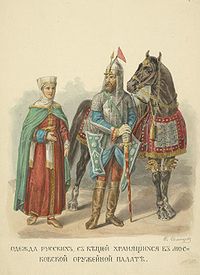 A warrior of the Russian noble cavalry (поместная конница) during the Russo-Polish War 1654–1667. The drawing is based on the pieces preserved in the Kremlin Armoury
A warrior of the Russian noble cavalry (поместная конница) during the Russo-Polish War 1654–1667. The drawing is based on the pieces preserved in the Kremlin Armoury
Russia continued its territorial growth through the 17th century. In the south-west, it acquired eastern Ukraine, which had been under Polish-Lithuanian rule. The Zaporozhian Cossacks, warriors organized in military formations, lived in the frontier areas bordering Poland, the Crimean Tatar lands, and Russia. Although they had served in the Polish army as registered mercenaries, the Cossacks of the Zaporozhian Host remained fiercely independent and staged a number of rebellions against the Poles. In 1648, the peasants of Ukraine joined the Cossacks in rebellion during the Khmelnytsky Uprising, because of the social and religious oppression they suffered under Polish rule. Initially, Ukrainians were allied with Crimean Tatars, which had helped them to throw off Polish rule. Once the Poles convinced the Tartars to switch sides, the Ukrainians needed military help to maintain their position.
In 1654 the Ukrainian leader, Bohdan Khmelnytsky, offered to ally Ukraine with the Russian tsar, Aleksey I. Aleksey's acceptance of this offer, which was ratified in the Treaty of Pereyaslav, led to a protracted war between Poland and Russia. The Truce of Andrusovo, which ended the war in 1667, split Ukraine along the Dnieper River, reuniting the western sector (or Right-bank Ukraine) with Poland and leaving the eastern sector (Left-bank Ukraine) as the Cossack Hetmanate, self-governing under the sovereignty of the tsar. However, the self-government did not last long and Eastern Ukraine was eventually fully incorporated into the Russian Empire.
Raskol
Main article: RaskolRussia's southwestern expansion, particularly its incorporation of eastern Ukraine, had unintended consequences. Most Ukrainians were Orthodox, but their close contact with the Roman Catholic and the Polish Counter-Reformation also brought them Western intellectual currents. Through the Ukrainian Academy in Kiev, Russia gained links to Polish and Central European influences and to the wider Orthodox world. Although the Ukrainian link induced creativity in many areas, it also weakened traditional Russian religious practices and culture. The Russian Orthodox Church discovered that its isolation from Constantinople had caused variations to appear between their liturgical books and practices.
The Russian Orthodox patriarch, Nikon, was determined to bring the Russian texts back into conformity with the Greek texts and practices of the time. But Nikon encountered opposition among the many Russians who viewed the corrections as improper foreign intrusions. When the Orthodox Church forced Nikon's reforms, a schism resulted in 1667. Those who did not accept the reforms came to be called the Old Believers; they were officially pronounced heretics and were persecuted by the church and the state. The chief opposition figure, the protopope Avvakum, was burned at the stake. The split afterwards became permanent, and many merchants and peasants joined the Old Believers.
The tsar's court also felt the impact of Ukraine and the West. Kiev was a major transmitter of new ideas and insight through the famed scholarly academy that Metropolitan Mohyla founded there in 1631. Other more direct channels to the West opened as international trade increased and more foreigners came to Russia. The Tsar's court was interested in the West's more advanced technology, particularly when military applications were involved. By the end of the 17th century, Ukrainian, Polish, and West European penetration had weakened the Russian cultural synthesis—at least among the elite—and had prepared the way for an even more radical transformation.
Conquest of Siberia
Main article: Russian conquest of Siberia Vasily Surikov. Yermak's Conquest of Siberia.
Vasily Surikov. Yermak's Conquest of Siberia.
Russia's eastward expansion encountered little resistance. In 1581 the Stroganov merchant family, interested in fur trade, hired a Cossack leader, Yermak Timofeyevich, to lead an expedition into western Siberia. Yermak defeated the Khanate of Sibir and claimed the territories west of the Ob and Irtysh rivers for Russia.
From such bases as Mangazeya, merchants, traders, and explorers pushed eastward from the Ob River to the Yenisei River, then to the Lena River and to the coast of the Pacific Ocean. In 1648 Cossack Semyon Dezhnyov opened the passage between America and Asia. By the middle of the 17th century, Russians had reached the Amur River and the outskirts of the Chinese Empire.
After a period of conflict with the Qing Dynasty, Russia made peace with China in 1689. By the Treaty of Nerchinsk, Russia ceded its claims to the Amur Valley, but it gained access to the region east of Lake Baikal and the trade route to Beijing. Peace with China strengthened the initial breakthrough to the Pacific that had been made in the middle of the century.
State flags
There was no single flag of Russia during the Tsardom. Instead, there were multiple flags:
- Standards used by the Tsar:[12]
- Standard of the Tsar of Moscow (1693–1700): white-blue-red tricolor with golden double-headed eagle in the center.[12] Replaced by the Imperial standard in 1700 (see below).[12]
- Imperial Standard of the Tsar of Russia: black double-headed eagle carrying St Vladimir red coat of arms, on a golden rectangular field, adopted in 1700 instead of the older white-blue-red Standard of the Tsar of Moscow.[12]
- Civil Flag: The early Romanov Tsars instituted the two-headed eagle Imperial flag of the Tsar, which origin dates back to 1472, as a civil flag, it remained the civil flag of Russia until replaced during the Empire in 1858.[13]
- Civil Ensign of Russia: the white-blue-red tricolor, that was adopted on 20 January, 1705 by decree of Peter I.[12]
- Naval Ensign of the Imperial Russian Navy: white field with a blue saltire, adopted in 1712.[14] Before that, the naval ensign of Russia was white-blue-red tricolor.[14]
-
Naval Ensign of the Imperial Russian Navy (1699–1700),[14] a transitional variant between the (1697–1699) ensign (tricolor) and the Andreevsky flag of 1712.
-
Naval Ensign of the Imperial Russian Navy (from 1712).[14]
See also
- Monarchs of Russia
- Coronation of the Russian monarch
Key texts
- Grigory Kotoshikhin's Russia during the reign of Alexey Mikhailovich (1665) is the indispensable source for those studying administration of the Russian tsardom
- Domostroy is a 16th-century set of rules regulating everyday behaviour in the Russian boyar families.
References
- ^ Хорошкевич, А. Л. Символы русской государственности. -М. :Изд-во МГУ,1993. -96 с. :ил., фот. ISBN 5211025210
- ^ Костомаров Н. И. Русская история в жизнеописаниях ее главнейших деятелей. Olma Media Group, 2004 [1]
- ^ Зимин А. А., Хорошкевич А. Л. Россия времени Ивана Грозного. Москва, Наука, 1982
- ^ Перевезенцев, С. В. Смысл русской истории, Вече, 2004
- ^ Richard Pipes, Russia under the old regime, page 83
- ^ Кудрявцев, Олег Фёдорович. Россия в первой половине XVI в: взгляд из Европы. Русский мир, 1997. [2]
- ^ Тихвинский, С. Л., Мясников, В. С. Восток—Россия—Запад: исторические и культурологические исследования. Памятники исторической мысли, 2001 — С. 69
- ^ Vernadsky V. Muscovite Tsardom. in 2 v. Moscow: Agraph, 2001 (Russian)
- ^ "В некотором царстве, в некотором государстве..." Sigurd Shmidt, Doctor of history sciences, academician of RAN, Journal "Rodina", Nr. 12/2004
- ^ ^ Richard Pipes, Russia under the old regime, page 80
- ^ Ruslan Skrynnikov. Boris Godunov. Moscow: Nauka, 1983. Reprinted 2003. ISBN 5-17-010892-3.
- ^ a b c d e f History of the Russian Flag (in Russian)
- ^ Yenne, Bill. Flags of the World. Chartwell Books, 1993, pg32
- ^ a b c d e vexillographia.ru
 This article incorporates public domain material from websites or documents of the Library of Congress Country Studies. - Russia
This article incorporates public domain material from websites or documents of the Library of Congress Country Studies. - Russia- Jarmo Kotilane, Marshall Poe (ed.), Modernizing Muscovy: Reform and Social Change in Seventeenth Century Russia, Routledge, 2004, ISBN 0-415-30751-1
Categories:- Former countries in Europe
- Former countries in Asia
- States and territories established in 1547
- States and territories disestablished in 1721
- History of Russia
- Early Modern history by country
- Former Slavic countries
- Tsardom of Russia
-
Wikimedia Foundation. 2010.




